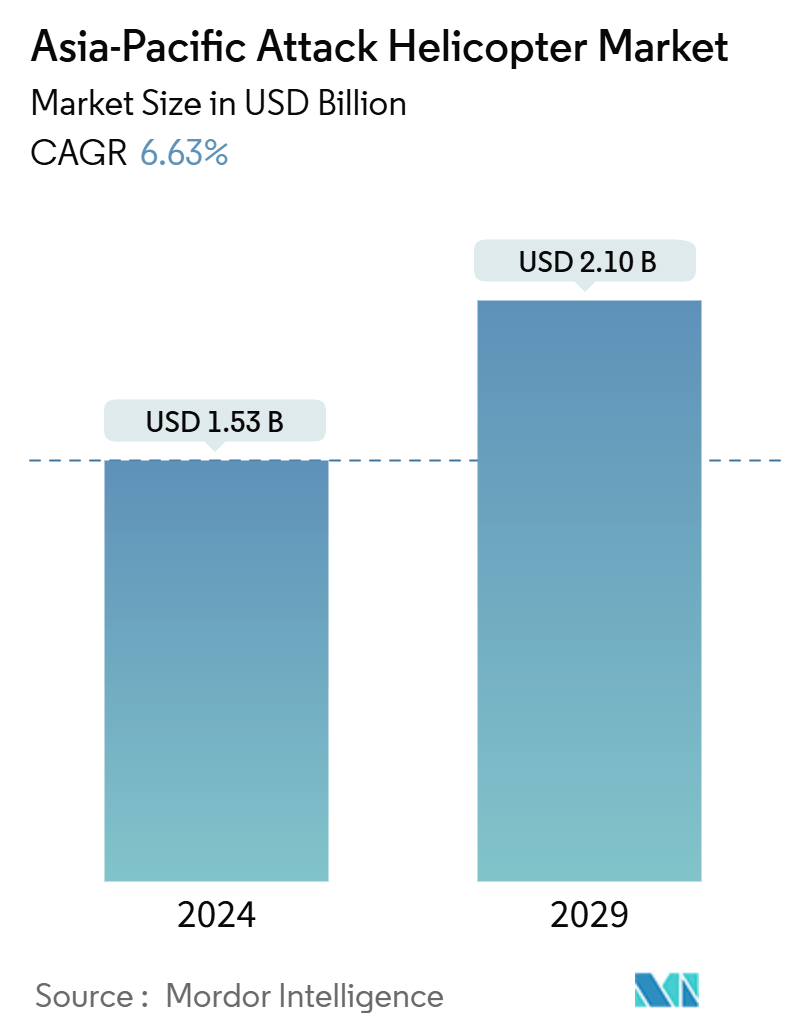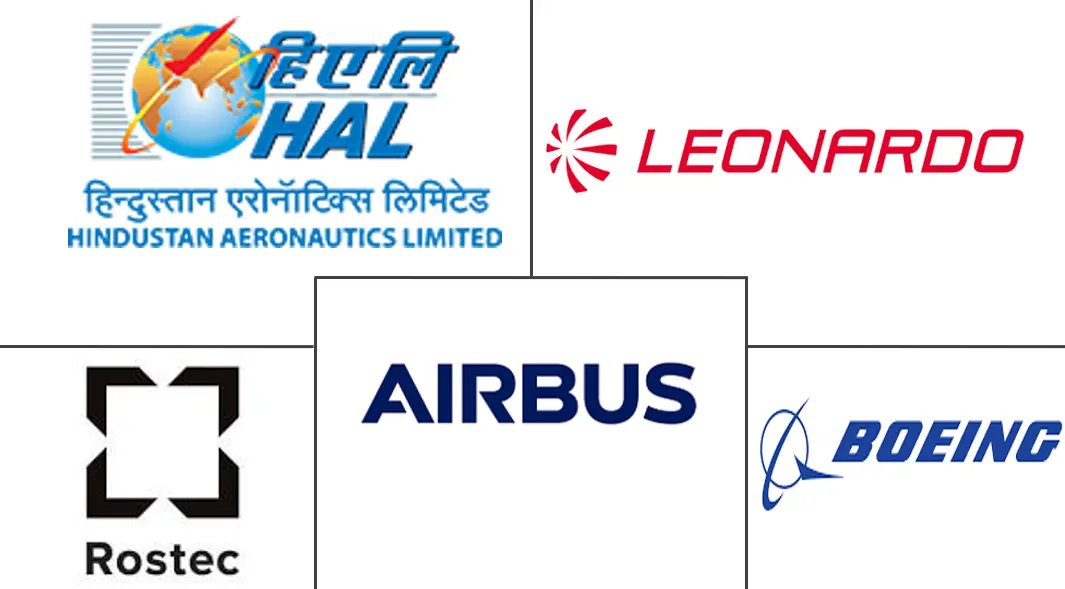Market Size of Asia-Pacific Attack Helicopter Industry

| Study Period | 2019 - 2029 |
| Base Year For Estimation | 2023 |
| Market Size (2024) | USD 1.53 Billion |
| Market Size (2029) | USD 2.10 Billion |
| CAGR (2024 - 2029) | 6.63 % |
| Market Concentration | High |
Major Players
*Disclaimer: Major Players sorted in no particular order |
Asia-Pacific Attack Helicopter Market Analysis
The Asia-Pacific Attack Helicopter Market size is estimated at USD 1.53 billion in 2024, and is expected to reach USD 2.10 billion by 2029, at a CAGR of 6.63% during the forecast period (2024-2029).
Major military powers in the Asia-Pacific region, including India, China, Japan, and South Korea, are consistently increasing their defense budgets. A significant portion of these budgets is allocated to upgrading and enhancing air superiority. This focus is driving the growth of the attack helicopter market in the Asia-Pacific.
Rising armed conflicts, terrorism, border tensions, and territorial breaches are boosting the demand for attack helicopters. Additionally, regional armed forces are leveraging advanced technologies to enhance the effectiveness of their attack helicopters, aiming for a tactical edge over adversaries.
Moreover, growing partnerships between local and global players aimed at reducing manufacturing costs and improving delivery rates are poised to create market opportunities during the forecast period. However, constrained defense budgets in several Asia-Pacific countries may limit their procurement of new attack helicopters and associated systems.
Asia-Pacific Attack Helicopter Industry Segmentation
Military branches, including the Army, navy, and Air Force, utilize attack helicopters for various battlefield operations. These helicopters are armed with various weapons, such as automatic cannons, machine guns, anti-tank guided missiles, rockets, anti-ship missiles, and air-to-air missiles. Their main functions include countering armored vehicles, offering close-air support to ground troops, conducting armed reconnaissance, transporting light troops, and executing deep penetration missions.
The Asia-Pacific attack helicopter market is segmented based on platform and geography. By platform, the market is divided into the army, navy, and air force. The report also offers market size and forecasts for five countries across the region. For each segment, the market size is provided in terms of value (USD).
| End-User | |
| Army | |
| Navy | |
| Air Force |
| Geography | |
| China | |
| India | |
| Japan | |
| South Korea | |
| Rest of Asia-Pacific |
Asia-Pacific Attack Helicopter Market Size Summary
The Asia-Pacific attack helicopter market is experiencing significant growth, driven by the increasing defense budgets of major military powers in the region, such as India, China, Japan, and South Korea. These countries are focusing on enhancing their air superiority capabilities, which is propelling the demand for attack helicopters. The market is further fueled by rising armed conflicts, terrorism, and border tensions, prompting armed forces to upgrade their helicopter fleets with advanced technologies for improved lethality and situational awareness. The adoption of stealth technology to enhance helicopter performance is also expected to contribute to market expansion. The Army segment is anticipated to witness the highest growth, supported by procurement and fleet modernization plans in countries like India, Japan, and South Korea.
China's substantial defense investments and modernization programs are significantly impacting the military helicopter segment's growth. The country's aggressive weaponry modernization, driven by border issues and regional tensions, is boosting domestic and global demand for attack helicopters. The market is highly consolidated, with key players like Boeing, Airbus, Hindustan Aeronautics Limited, Leonardo S.p.A., and Rostec State Corporation holding significant shares. Collaborations between local defense manufacturers and global players are enhancing domestic production capabilities. Notable developments, such as Australia's acquisition of AH-64E Apache helicopters and the involvement of Australian companies in supplying components, are expected to bolster the growth of domestic players in the region.
Asia-Pacific Attack Helicopter Market Size - Table of Contents
-
1. MARKET DYNAMICS
-
1.1 Market Overview
-
1.2 Market Drivers
-
1.3 Market Restraints
-
1.4 Porter's Five Forces Analysis
-
1.4.1 Threat of New Entrants
-
1.4.2 Bargaining Power of Buyers/Consumers
-
1.4.3 Bargaining Power of Suppliers
-
1.4.4 Threat of Substitute Products
-
1.4.5 Intensity of Competitive Rivalry
-
-
-
2. MARKET SEGMENTATION
-
2.1 End-User
-
2.1.1 Army
-
2.1.2 Navy
-
2.1.3 Air Force
-
-
2.2 Geography
-
2.2.1 China
-
2.2.2 India
-
2.2.3 Japan
-
2.2.4 South Korea
-
2.2.5 Rest of Asia-Pacific
-
-
Asia-Pacific Attack Helicopter Market Size FAQs
How big is the Asia-Pacific Attack Helicopter Market?
The Asia-Pacific Attack Helicopter Market size is expected to reach USD 1.53 billion in 2024 and grow at a CAGR of 6.63% to reach USD 2.10 billion by 2029.
What is the current Asia-Pacific Attack Helicopter Market size?
In 2024, the Asia-Pacific Attack Helicopter Market size is expected to reach USD 1.53 billion.

